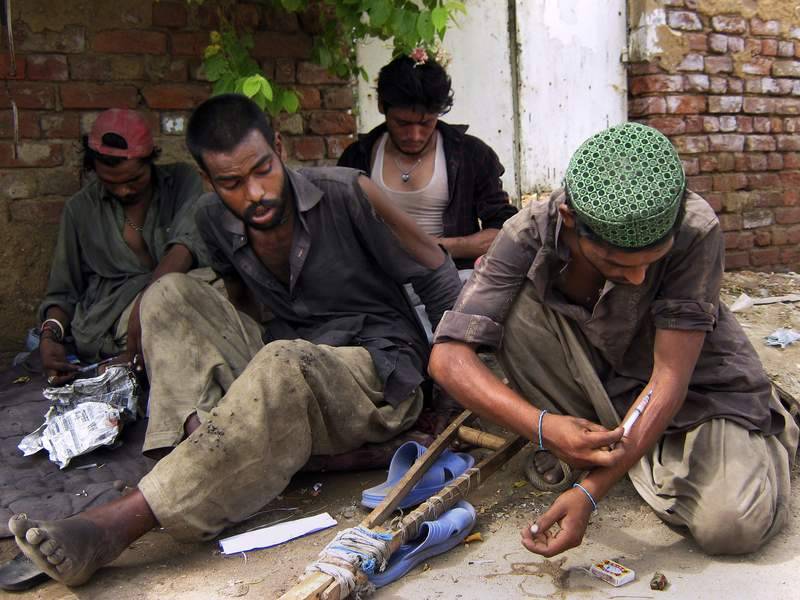People take drugs to bring change in their lives. Thinking that drugs give relaxation, relief from boredom and anxiety, young people take them abundantly. The trend of drugs abusing is thriving rapidly among youth throughout the world. Although the addiction of drugs abusing brings nothing but the devastating consequences for its users, yet they use it carelessly and unknowingly. The beneficiaries of the production, trafficking, and consumption of the drugs are terrorist organizations which generate huge revenues for their survival.
Drug trade and terrorism are totally different forms of crimes. However, the two exist in combination, somewhat like a horse and carriage. Drug trade is not just a criminal issue, not just a health and safety issue, but it’s a national security issue because it is funding and fueling terrorists. To raise funds to carry out operations; to conduct trainings of their members and to provide aid to the families of suicide bombers, Afghan Taliban groups cultivate, produce, smuggle opium and patronize these activities for which they are paid substantial amount of money and Pakistan Taliban groups facilitate smugglers in drugs trafficking providing them with safe transit route. Afghanistan produced an estimated 80 per cent of the world's supply of illicit opium and more than 40 per cent of drug is smuggled from Afghanistan into Pakistan that is supplied to destination markets in Europe, Asia and to some extent, Africa and North America.
Initially, Taliban terrorists were mortal enemies of the drug producers and traders. On the basis of Islamic ideology they opposed the use of drugs and punished those in their ranks who violated this rule. But when all or other main sources of raising funds for their operations, training of their members and so-called humanitarian relief such as assistance to the families of suicide bombers or other victims of the cause or struggle were ceased, they practiced and patronized the production and smuggling of drugs/opium.
According to the reports of the United Nations Office on Drugs and Crime (UNODC), a total of about 246 million people – slightly over 5 percent of those aged 15 to 64 years worldwide – used an illicit drug in 2013. Some 27 million people are problem drug users, almost half of whom are people who inject drugs (PWID). An estimated 1.65 million of people who inject drugs are living with HIV in 2013. Approximately 187,100 drug-related deaths occurred in 2013. In some countries, women who inject drugs were more vulnerable to the HIV infection than men and the prevalence of HIV can be higher among such women compared to men. The number of new HIV infections among drug injectors declined by roughly 10 per cent between 2010 and 2013: from an estimated 110,000 to 98,000. However, the drug report also indicated that many risk factors, including the transmission of infectious diseases such as HIV and Hepatitis C and the incidences of drug overdoses, caused the death rate among PWID to be 15 times higher than in the rest of the population. Some 32.4 million people or 0.7 per cent of the world’s adult population were users of pharmaceutical opioids and opiates such as heroin and opium. In 2014, the global potential opium production reached 7,554 tons – the second highest level since the 1930s, mainly due to its cultivation increasing significantly in Afghanistan, the main growing country.
Afghanistan is the world’s largest opium producer. It grows about 80 percent of the world’s opium, which is used to produce highly addictive heroin. The Asian continent is the largest market for opium. The US is the largest consumer of opium/heroin. The African continent is a transit hub for Afghan heroin bound for Europe and other regions. According to latest reports of the UNODC, Afghan poppy fields covered some 209,000 hectares in 2013, 224,000 hectares in 2014 and 310,891 hectares in 2015 which is at its highest since the late 1930s. Estimated global production of opiates meanwhile doubled in two years from 3,700 tons in 2012 to 7,554 tons in 2014. Afghanistan accounted for 80 percent of the global output. The huge amount of opium is supplied to the US and the UK. Thus more and cheaper heroin is available in the US. As a result, the US has a large number of heroin related deaths. In the UK heroin related deaths has increased recently. While the number of heroin users is increasing with fast speed in China. In Pakistan around 4.25 million people are drug dependent with a substantial proportion of population aged 15 to 64.
Although Pakistan has made very impressive contributions against cultivation of poppy in its territory and had been acknowledged as a poppy-free State for the year 2011 and had retained the same status for 2012, 2013 and 2014, yet the matter of concern is that the consumption and trafficking of drugs such as opium, heroin, cocaine and marijuana is on the pinnacle in Pakistan. A large number of youth has become a victim to drugs especially in Afghanistan bordering provinces—Balochistan and Khyber Pakhtun Khuwa. Both Afghanistan and Pakistan have to take serious measures to stop production and trafficking of opium which like terrorism affects people of the whole world and causes colossal deaths worldwide. To purge the world of illegal drugs, it is imperative to wipe out terrorism from Pakistan and Afghanistan completely.






